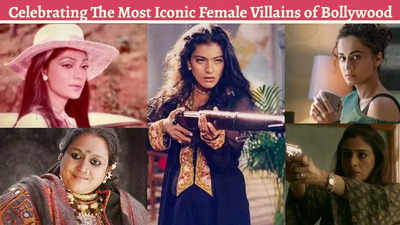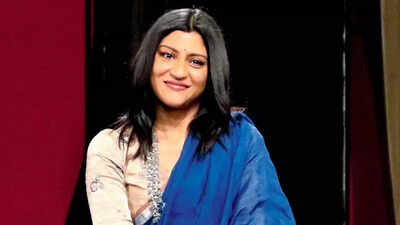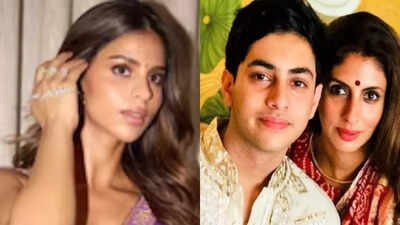Tabu, Supriya Pathak, Kajol – Celebrating The Most Iconic Female Villains of Bollywood |

A pinch of the right spice in the right recipe can elevate the taste of any delicacy, and the formula is the same for Bollywood movies. In a cinematic landscape, where heroes and heroines often bask in the limelight, it’s the villains who add depth and intrigue to the narrative. On top of that, if a female plays a grey shade and entices with her complex portrayal of a negative character, the standard further rises.
The Evolution of Female Villains in Bollywood
In the initial days, female villains were typically characterized as vamps. In Indian cinema, they were depicted as figures who leveraged their charm to deceive men, representing moral decay.
However, as Bollywood progressed, the portrayal of female antagonists also transformed; it turned more complex and had more meat in the writing and execution.
Celebrating the Most Iconic Female Villains of Bollywood
Simi Garewal as Kamini in ‘Karz’ (1980)
With a beauty that could bring any man to his knees, Simi Garewal was one of the most charismatic actresses of her time. Her character Kamini in ‘Karz’ remains one of the most chilling performances in Bollywood history.
Kamini is introduced as a modest and naive bride, but her shocking evolution into a ruthless killer who murders her husband for riches is both startling and intriguing. Garewal skillfully shifts between charisma and threat, adding depth to Kamini’s character and making her an unforgettable villain.
Kajol as Isha Diwan in ‘Gupt: The Hidden Truth’ (1997)
The moment you think about Kajol, the first movie that comes to mind is ‘DDLJ.’ Kajol, as Simran, was the quintessential Indian heroine of that era, yet she broke that image and took on the role of Isha Diwan in ‘Gupt: The Hidden Truth.’ She played the role of a possessive lover with a dark side. She brought an obsessive and psychopathic killer on the screen and was highly praised for it.
“It was the shock value of the film, the character and the fact that nobody expected it to come. It was gutsy at that time to do it. It’s the story and role that’s what really got me to do it,” Kajol told PTI in an interview.
In the same interview, she shared how her mother, veteran actress Tanuja, reacted to her work and the movie. Kajol recalled her mother exclaiming ‘What a film!,” which for the actress was the best compliment ever.
Tabu as Simi Sinha in ‘Andhadhun’ (2018)
You say versatility, we say Tabu. She is one of those rare gems who has only shone brighter with the changing time. In her career that spans over decades, the actress has done diverse roles, which includes negative characters as well. Be it her work in ‘Maqbool’ or in ‘Andhadhun,’ she has always been appreciated for picking up roles that offer a challenge to an actor.
In ‘Andhadhun’ she played the role of a seemingly normal woman who harbors dark secrets. Simi’s actions drive the film’s suspense.
Speaking about the movie and her character, Tabu, during the Pune International Film Festival said,“ This film gave me the chance to inhabit a space I have never previously occupied. The role was challenging and impactful in its own way and you cannot really craft what you are going to do. I had to be ten steps ahead in thought, but we had to be careful to not make the character caricaturist or let it go overboard.”
She continued, “Every character, before they are heroes or villains, they are human beings. And I like to work from that point of view because you cannot deny every other emotion s/he feels and only bring to fore one to suit the screen.”
Supriya Pathak as Dhankor in ‘Ram-Leela’ (2013)
Who could have imagined that Supriya Pathak, who was celebrated as ‘Hansa Behn’ for decades can take over a fierce matriarch role? Well, Sanjay Leela Bhansali could! By joining hands with Supriya Pathak, Sanjay brought ‘Dhankor,’ to life – an intense and fierce matriarch in ‘Ram-Leela’. With this role, the actress showcased her ability to embody a character that is unpredictable and manipulative. Her formidable presence and steely resolve made her a memorable antagonist.
Recently, Sanjay Leela Bhansali’s official handle also celebrated this iconic role of the actress with the post that read – “One stare from Dhankor Baa is enough to send chills down anyone’s spine! #SupriyaPathak truly brought alive the pillar of the Saneras, a character with true strength, depth, and commitment towards her own ❤️”
Taapsee Pannu as Naina in ‘Badla’ (2019)
In ‘Badla,’ Taapsee Pannu played the role of Naina, a woman accused of murder who consistently claims her innocence. The unveiling of her character and her absence of remorse brought depth to her role, making a significant impact on viewers.
Vidya Balan as Krishna in ‘Ishqiya’ (2010)
Vidya Balan’s depiction of Krishna, a widow with ulterior motives, highlighted her talent in portraying a character that is both alluring and cunning. Her performance enriched the film’s storyline, establishing her as an unforgettable antagonist.
In an earlier ETimes report, Vidya Balan spoke about the portrayal of women in cinema where she said, “In films, there is either the bitch or the bechari, but I’ve never done films [with such black-and-white parts]. Women-led cinema is on a nascent stage here.”
Further, while talking about ‘Ishqiya’, she said, “Ishqiya (2010) stood out during its time. Even though it’s been 14 years, we’re still figuring out the rules. They’ll develop, change, and evolve. It’s time to reconsider the types of women’s characters we’re creating. I believe more films nowadays are portraying strong women in different ways. Even in women-centric films, it’s important not to take ourselves too seriously. The crew may not always be perfect, but as long as we’re having a good time, that’s what matters.”
In a nutshell
The femme fatales of Bollywood have left an indelible mark on Indian cinema, captivating audiences with their charm, complexity, and cunning. As Bollywood continues to evolve, the portrayal of female villains serves as a testament to the industry’s growing commitment to diverse and multifaceted storytelling.






